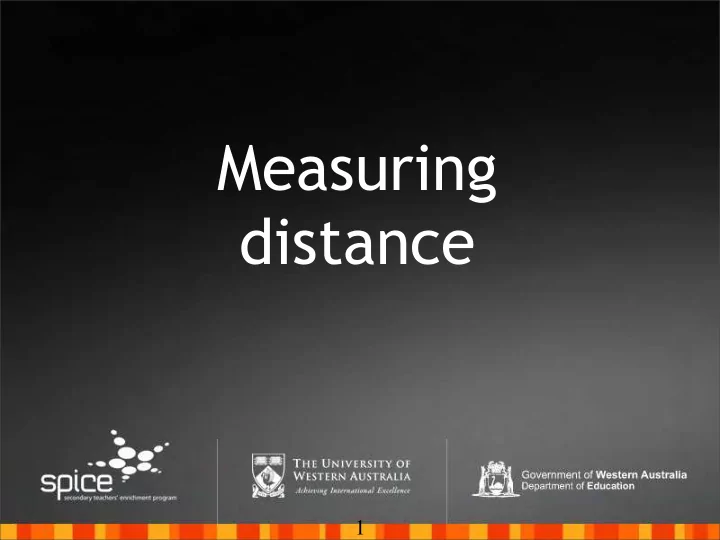

Measuring distance 1
What do we know about distances to our nearest neighbours in space? 2 ‘Our Solar System’, image: NASA/JPL
The night sky is full of interesting objects. Is it possible to tell which objects are closest to us? What makes us think that a particular object is closer to us? 3
In the late 1960s, humans journeyed to the moon for the first time. The Apollo spacecraft took 3 days, travelling at 20 000 km/hour, to get to the moon. 4
To explore space we need to know how far away things are. 5
To explore space we need to know how far away things are. From this scale diagram, is it possible to estimate the distance from the Earth to the Moon? Hint: 12,756 km How was this scale diagram produced in the first place? 5
Here are two images of the Moon taken at the same time but from different locations on Earth. What is different between the two images ? 6
Here are two images of the planet Mars taken on the same night, but from different locations on Earth. What is different between the two images ? 7
1 2 What do changes in the background tell us about how far away we are from an object? 8
Simple parallax activity Simple parallax activity 9
Simple parallax activity 22 16 10m 10
Simple parallax activity 2 2 1 6 20m 11
The apparent movement of an object against its background is called parallax. What is the effect of moving the observers further apart? 2 2 1 6 How can parallax be used to measure how far away an object is? 12
Let’s re-examine the images of the Moon. When observed from two locations, the Moon appears surrounded by different stars. 13
How does the distance between observer and object affect parallax? 14
Let’s re-examine the images of Mars. Why does Mars appear in the same position for both observers? 15
How can we increase the parallax for very distant objects such as stars? Sun 16
How can we increase the parallax for very distant objects such as stars? Sun How can the measurement of distant stars be further improved? 16
Ground-based stellar parallax allows us to measure the distance to the nearest few hundred stars. Unhindered by the effects of the Earth’s atmosphere, the Hipparcos satellite allowed us to measure the distance to about 100,000 stars. This distance does not even get us to the centre of the Milky Way galaxy! The limit of Hipparcos measurements 17
Astronomers use other techniques to measure the distance to stars that are too far away to be determined by parallax. 18
When we look at stars in the night sky, some appear brighter than others. Why might the stars be of different brightness? 19
What happens to the brightness of this globe as it is moved further away? apparent brightness absolute brightness 20
What happens to the brightness of this globe as it is moved further away? apparent brightness absolute brightness 20
What must we do to compare the absolute brightness of different globes? 21
This image has stars of different brightness. Can you tell which is the closest star? 22
Plot these values for 10 different stars on the graph paper in your worksheet. STAR A STAR B brightness: 4 brightness: 8 distance: 10 distance: 90 STAR J brightness: 5 distance: 90 STAR C brightness: 1 distance: 20 STAR I brightness: 1 distance: 50 STAR D brightness: 10 STAR H distance: 30 brightness: 2 distance: 30 STAR E brightness: 7 STAR G distance: 60 brightness: 5 distance: 50 STAR F brightness: 3 Is there a simple pattern connecting the apparent distance: 80 brightness of stars to the distance from us? 23
Not all stars are the same. Astronomers need to know the absolute brightness of stars in order to determine their distance. For one special group of stars the absolute brightness can be worked out. 24
Astronomers discovered pulsating stars called Cepheid Variables that brighten and dim at regular intervals. absolute brightness time 25
Cepheid variables pulse according to a simple pattern - stars with a high absolute brightness pulse at a slow rate. absolute brightness time absolute brightness time How does this help us to measure how far away a cepheid variable is? 26
Cepheids that pulse at the same rate are the same absolute brightness. absolute brightness time absolute brightness In this starfield the two cepheids are pulsing at the same rate. time Which of these two cepheid variable stars is closer ? 27
Using cepheids astronomers have been able to measure distances to other galaxies. Large Magellanic Cloud (LMC) NASA, ESA and the Hubble Heritage Team (STSCl/AURA)-ESA/Hubble Collaboration Andromeda galaxy (M31) NASA/JPL-Caltech/UCLA The Milky Way galaxy is about 70 000 light-years across. About 700 Cepheid variables have been discovered in the Milky Way. The Milky Way belongs to a local group of galaxies, about 3 000 000 light-years across. 28
Most of the galaxies that astronomers observe are so distant that individual stars (including any cepheids) cannot be resolved. In order to determine the distance to these galaxies, astronomers use another type of object. Some supernovae have a known absolute brightness ... they can be used to measure distance. Objects such as cepheids and supernovae that have a known absolute brightness are called ‘standard candles’. picture of SNe Supernova 1994D in galaxy NGC4526 NASA, ESA, The Hubble Key Project Team, and The High-Z Supernova Search Team 29
The basics of the cosmic distance ladder Stellar parallax is the only way of directly measuring the distance to the stars. Parallax allows us to measure distance to stars within our sector of the Milky Way galaxy. Standard candles, such as cepheid variables and supernovae, provide us with an indirect way to measure the distances to other galaxies. Measuring distance is fundamental to our quest to understand the origin and evolution of the universe. 30
Recommend
More recommend